Supporting children with Rett Syndrome and their families when confined to home
We are currently experiencing a pandemic of COVID-19. All countries are recommending frequent washing of hands, avoiding touching your face, covering coughs or sneezes with a tissue or flexed elbow, and avoiding close contact with others, especially anyone who has a cold or flu-like symptoms. Additional measures to protect public health include community-wide initiatives that limit abilities to move about in the community. According to your country’s guidelines, attendance at schools and gatherings will be restricted. As for other family members, children and adults with a disability will be spending long hours within their home setting – of necessity because of these directives.
This resource has been put together by an international group of therapists, advocates, and parents who are passionate about supporting girls with Rett syndrome to lead a good quality of life. This resource contains ideas that may be helpful for you and your child with Rett syndrome whilst you are spending more time at home. The ideas are based on the concept of participation, that is meaningful involvement in activities of daily life, with focus on the home setting.
General Principles and Activity Ideas
- Explain the situation to your child with simple words and pictures. Talk to your child about COVID-19 and why you are at home. A nice simple version can be found at the end of the document in the autism resource in the list of Online Resources.
- Plan a daily schedule with time allocated to the needs of everybody in your family, which of course can change. Beware not to overwork.
- Maintain routines for waking and sleeping. Continue to use your routines that help with settling and sleep.
- Continue with therapy activities you already may have to support your child to achieve their activity, self-help and communication goals.
- Encourage your child’s participation in their activities of daily living and household chores.
- Look for opportunities for your child to make choices whilst participating in their activities of daily living, household chores and other fun activities.
- Be active – help them to stand for some activities and walk for some tasks, being as active as possible in indoor and outdoor environments.
- Do activities together and with other family members.
Household chores
- Cooking
- Choosing what to prepare for meals and what vegetables go into the cooking.
- Helping to mix ingredients.
- Smelling to check that the cooking is good – smelling basil when making a pesto.
- Making sweet treats such as cupcakes or cookies, including lots of choice making. For example, the child chooses
- How the cupcake should be decorated?
- Which colour should the frosting have?
- Chocolate buttons or no chocolate buttons?
- Whipped cream or no whipped cream?

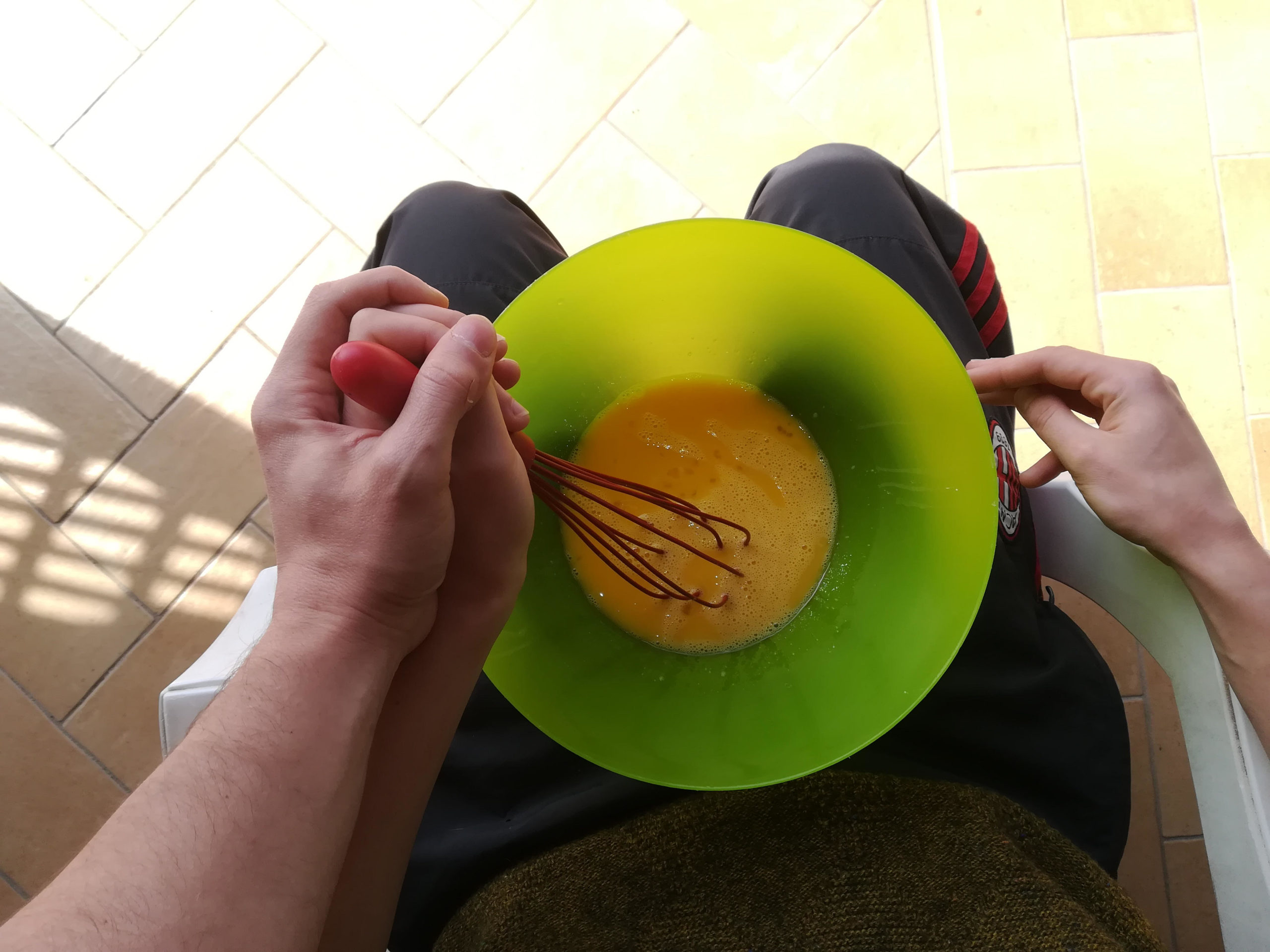
- Making small pizzas where they choose what they would like to have on their pizza – ham, pepperoni, beef, chicken, olives, cheese, etc.
- Participating in kitchen activities whilst standing up. Your child could use 0/1 contacts (with a Powerlink) to activate kitchen appliances such as a blender, the stand mixer, or help make the coffee by activating the coffee grinder.
- Helping with chores such as putting out the trash, bringing in the washing.
- Include outdoor chores: watering in the garden or “washing the car”.
Personal care
- Make a schedule for awake, rest and sleep time. If you have cards, create a daily schedule of pictures for the activities. Enable choices, e.g., which clothes to wear.
- Hairdresser games – brush hair to make funny pigtails and braids, or put on make-up or nail polish.
- Massage-therapy for the hand, feet or shoulders. Use different sensory stimulation – e.g. a soft brush, feathers, a ball, a smooth stone. Let them choose – do it for 5 mins and let them choose again.
- You can make your child more active by asking “do you want more, or should I stop?” or “Do you want me to continue?” every time you stop.
- They can answer by pointing to more/stop or yes/no symbols with their eyes (or hands), they can use two talking switches with ‘more’ and ‘stop’ or ‘yes’ and ‘no’ recorded on them, they could use their eye-gaze computer if they have one, or they can express it by using bodily expressions.
- Different sensory stimulation of their hands (or feet). Perhaps use this as a part of hand washing activities.

Learning and Education
- Reading books with siblings and adults in the house. Read to each other.
- Look online in your area as many librarians are hosting virtual story hours.
- Look at Youtube videos of favorite books or websites where you can click on books to be read to your child: https://www.storylineonline.net/
- Art activities such as painting or gluing. Let them choose which shapes or colours you should paint or what to glue together.
- Playing instruments with siblings and adults in the house.
- Singing with the family for fun and as a choice making activity, e.g., record every second line on a Bic Mack step-by-step. Family sings the first line and then stops, child sings the next line by pushing the button on the BigMack, and so on.
- Foot painting. At first, you can look at paintings by professional artists on the internet and talk about what you like. For this activity you need paper, paint (like finger paint) and your feet. A4 size paper can be taped together and form a large canvas. Then walk on paper with paint on feet, different sizes of feet, and different colours makes it more exciting. If one liked mountains or houses, try to copy the shapes and colours from favourite paintings. Can be followed by a footbath.
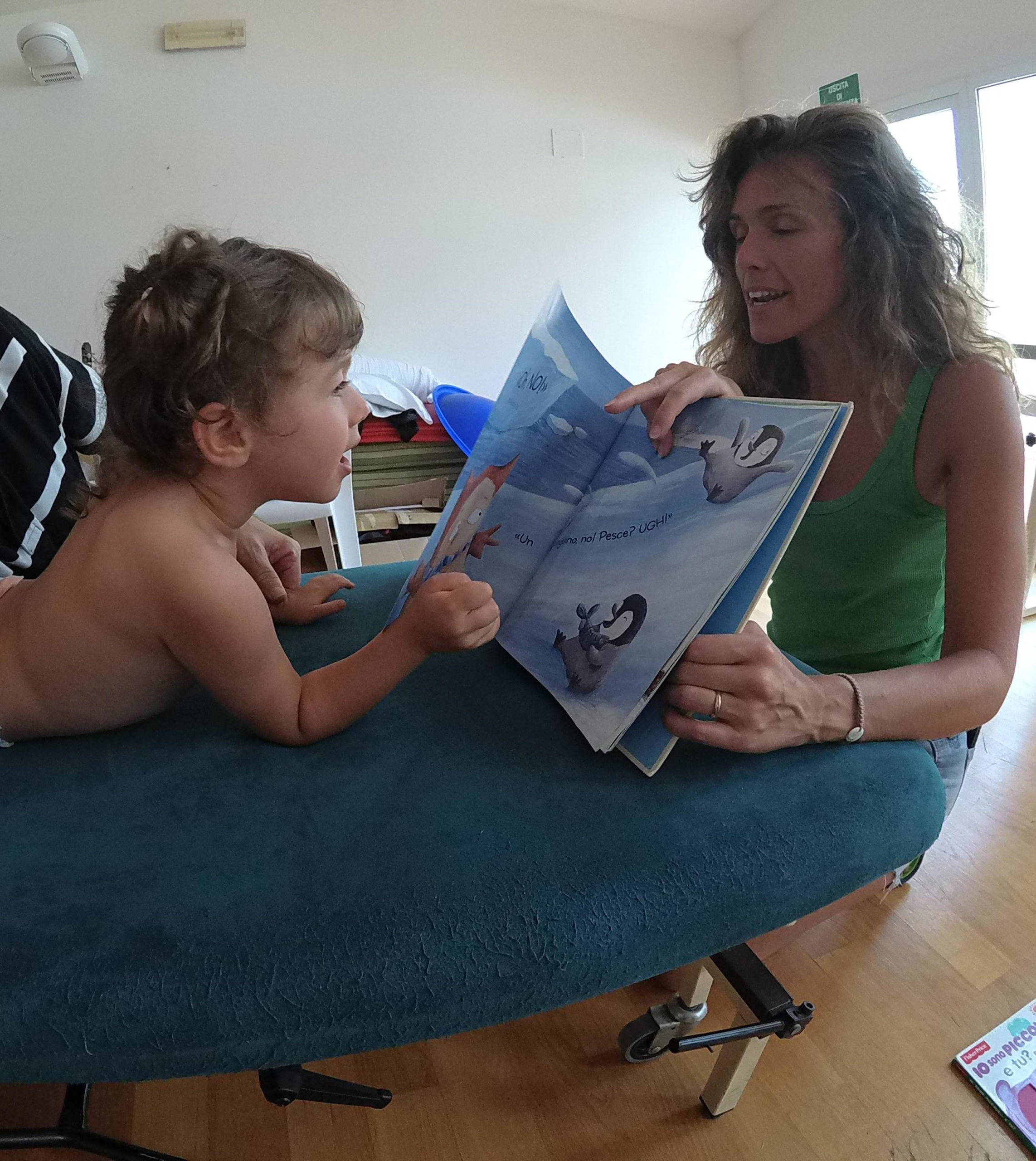
Exercise and Activity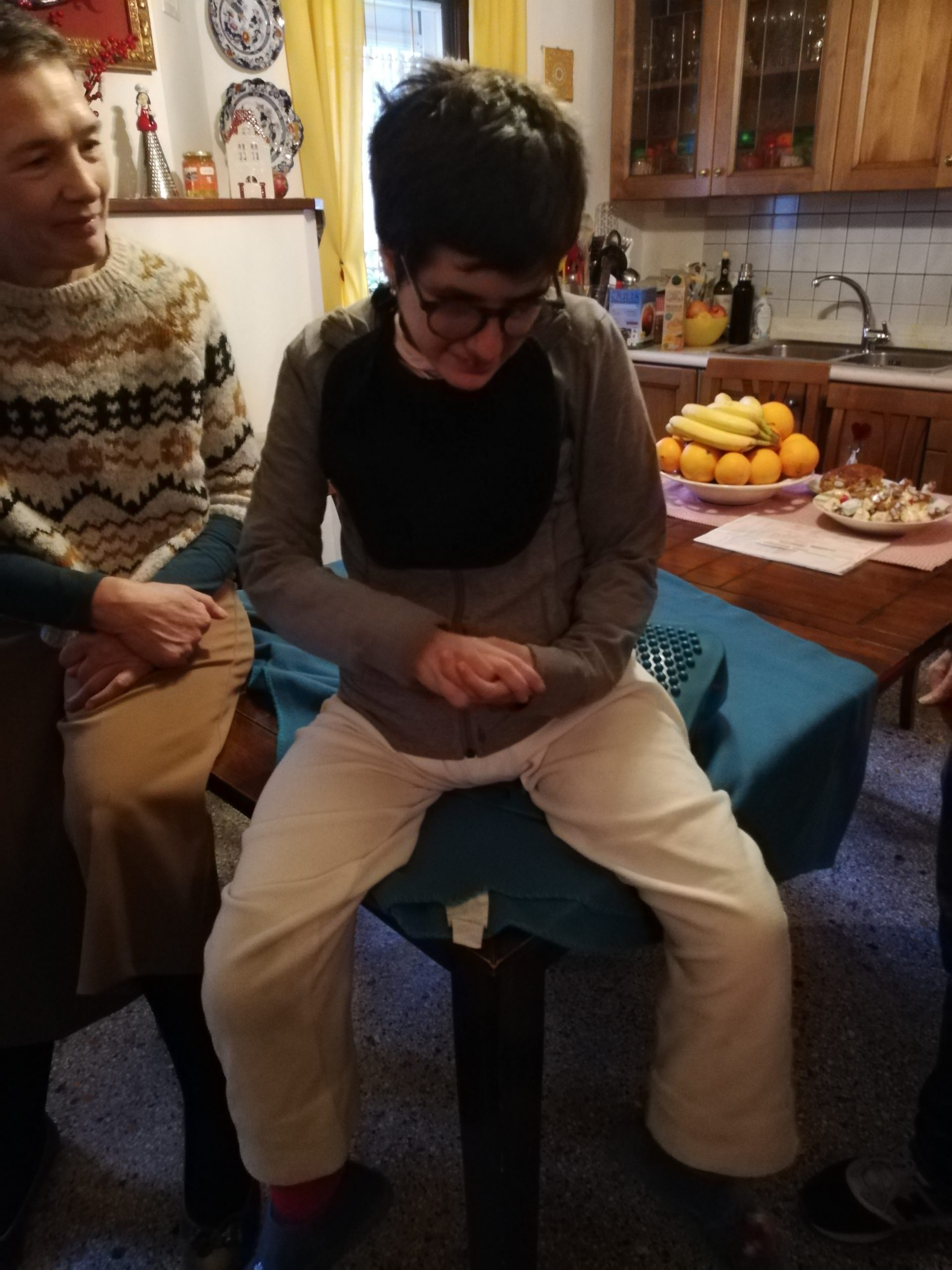
- For individuals who spend a lot of time during the day sitting in a wheelchair or sofa, sitting at the edge of the sofa or on the edge of a table could be a good exercise for improving balance
- Tummy time – Mom, Dad or someone else lies on their tummy also and the child can make choices to develop the story, e.g., what are the characters, colours, background and so on.
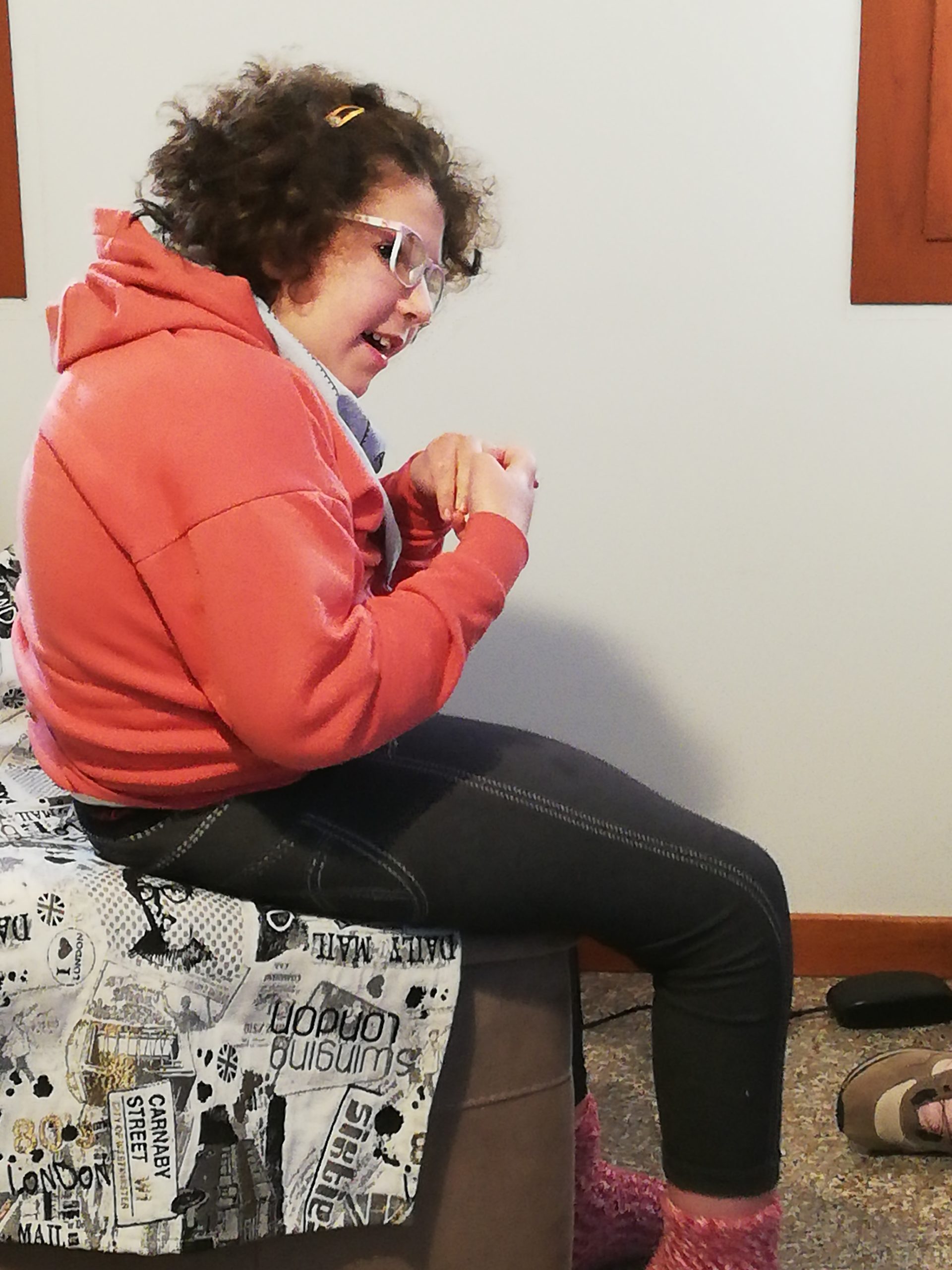
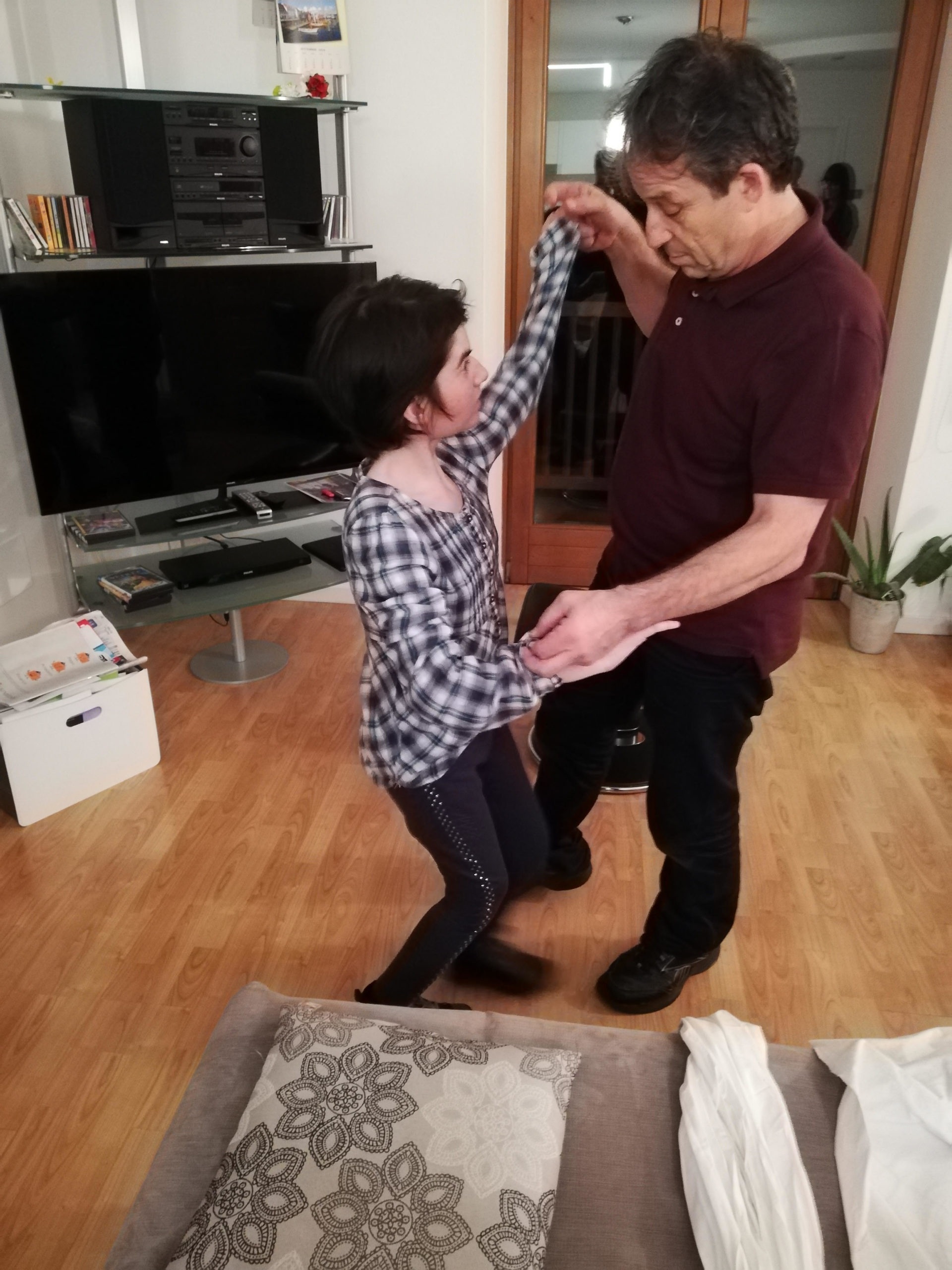
- Walking in the house and garden – on the flat/ slopes/ steps/ lawn.
- If you are allowed to leave the house and live in a rural area, walk outside in the bush/forrest, on uneven terrain, or go up and down hills. If you live close to the sea, walk on the beach or in shallow waters.
- Stepping and dancing to music – this good for stamina and balance. Let your child and siblings take turns to choose the music. If the person with Rett syndrome can’t walk by themself, put music that you both like and dance with the wheelchair or a walker if you have one at home. It’s good for morale, and it is also good exercise for you.
- Stand in a standing frame while listening to music or audiobooks. Use it while eating with other family members while watching TV or when participating in cooking in the kitchen.
- If you don’t have a standing frame, consider how your furniture could be used to support standing practice, such as in the photos.
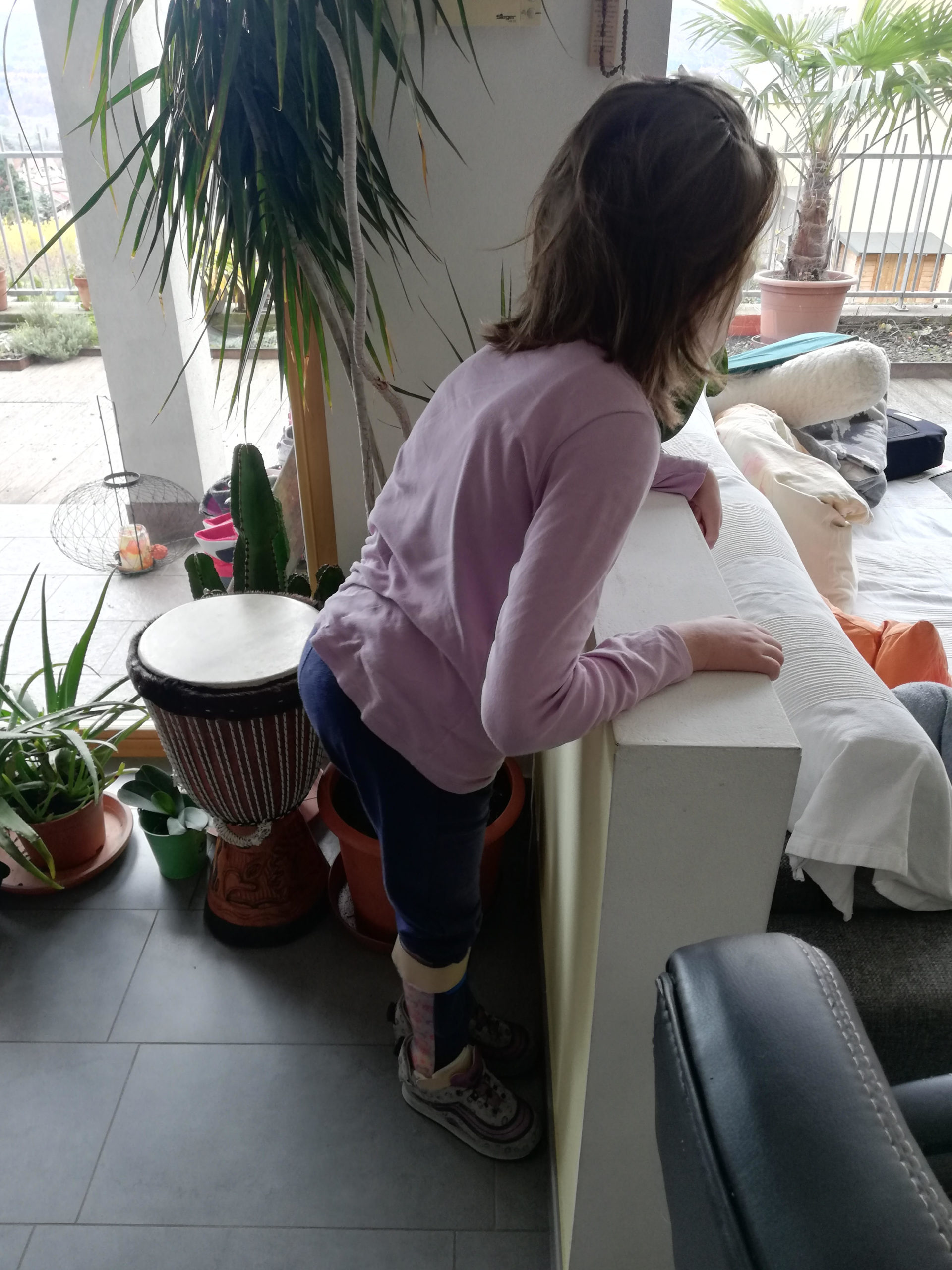
Indoor Play and Games
- Build an indoor house or tent and play inside. If you have a garden, build one outside.
- Doll play –
- Make different symbols/pictures/simple drawings with what can be done with the doll, e.g., change the doll’s clothes, change the diaper, tuck the doll into, bath doll, etc.
- Arrange the symbols so that they can use their eye gaze and for them to choose what should be done with the doll, and then you do it together.
- Paper dolls – Let the child choose what the paper doll should wear.
- Playing games with bubbles or with sensory toys such as in the photos – an opportunity also for extra time practicing sitting or standing.
- Create a bin of plastic balls, oats, sugar, dry beans or split peas, etc. to submerge hands or feet. You can move their hands or feet through the bins. When finished, use a warm washcloth to wipe down the skin and then apply lotion. Sing favourite songs or playing music as you go.
- Dress up in favourite clothes and dance/ move to music of own choice.
- Playing games on a tablet that involve choice-making, e.g.,
- A tea-party where the player can choose which napkins, plates, and cups to put on the table and the food be served.
- On a tablet, it may be difficult for your child to point to their different choices. Instead, you can use a pipe cleaner where you fold a small circle at the end of it, so when you put it on one of their choices, the pipe cleaner accentuates the choice.
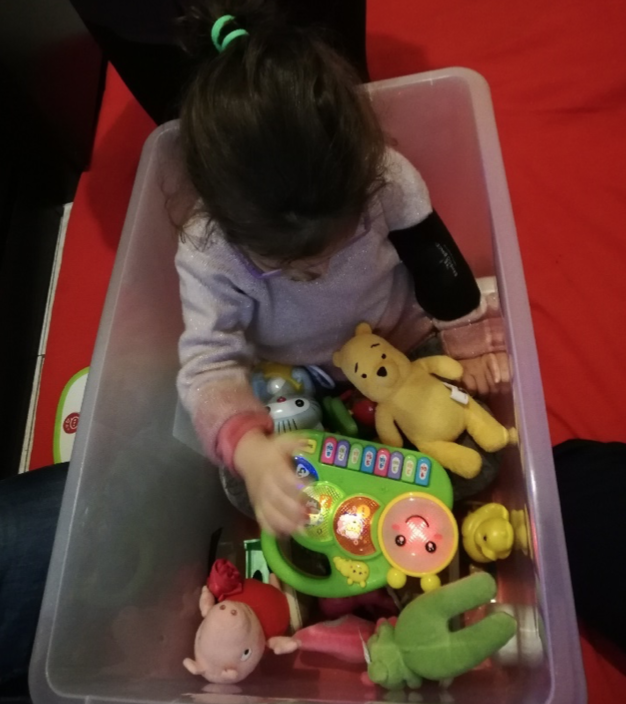
How to make a toy with jello or hair gel
You will need a gallon-size plastic zip lock bag, reinforcing tape (duct, gorilla or electrical tape), water, Jello, or a container of hair gel.
- If using just water, fill the bag and add beans, carrot pieces, jelly beans, gummy bears, sprinkles, plastic rings, etc. and then seal the bag. Pressing on the bag will make the items move around.
- If using gel, pour it in the bag and add the small items and seal the bag you are ready to go. (If gel is clear, you can add food colouring, if you would like)
- If you use flavoured jello, add an extra ¼ cup of water so that it doesn’t completely solidify when refrigerated—you want it to be the consistency of jelly.
Then, add pieces of pineapple, orange slices, or small plastic toys with smooth edges that can move around in the bag. After adding, seal and reinforce all edges with the tape to prevent leakage. Place filled bag on wheelchair tray or kitchen/dining room table and encourage reaching with hands, leaning with elbow, touching with feet.
Social Interaction at Home
- Enjoy the social experiences of mealtimes.
- Meet using Facetime or Zoom with your family and friends. Check in regularly.
- Take time to chat and look through photo albums.
- Make your own photo album. Perhaps using an eye gazing computer or in a “real” album where your child gets to decide which pictures should be in it.
- Give sensory stimulation such as hand or foot massage when you are talking or listening to music together. Make a playlist of songs they like. If they prefer, they can listen to their songs using a headset.
- Make a family book of memories or things that you are thankful for each day!
Nature and the Outdoors
- Spend time on the patio or in the garden, picking herbs or flowers. Make a few holes on the cap of a plastic bottle and water the flowers. Help your child to walk from flower to flower with you and water the flowers lightly squeezing the bottle.
- Walk barefoot in the garden.
Bouncing on a trampoline while lying prone or supine, sitting or standing. - Playing on swings and slides.
- Rolling on the grass or mattresses.
- Playing hide and seek assisted. One can do this in-door and out-door.
- Playing on swings or slides.
- If you are able to, play outside and go for walks in wide open spaces – choose parkland, bushland, and quiet beaches not playgrounds. Or take your dog for a walk.

Switches and switch operated toys can be purchased at:
https://www.adaptivetechsolutions.com/switches-accessories/switches/
https://enablingdevices.com/product-category/adapted-toys-games/
https://napacenter.org/benefits-of-switch-adapted-toys/
https://www.especialneeds.com/shop/assistive-technology/switches.html?p=1
https://www.etsy.com/listing/487742816/adapted-bubble-machine-switch-adapted
Online Resources
Public health guidance of how to protect yourself during the pandemic:
https://www.cdc.gov/coronavirus/2019-ncov/prepare/prevention.html
https://www.who.int/emergencies/diseases/novel-coronavirus-2019/advice-for-public
Supporting Individuals with Autism in Uncertain Times is a resource developed at the University of North Caroline and is available for free. This resource has visual representations that could be helpful in explaining COVID-19 to your child/ren, for choice-making between different at-home activities, and for thinking of tasks within household chores that could be a specific task for your child.
https://afirm.fpg.unc.edu/supporting-individuals-autism-through-uncertain-times
An amazing list of activities – created by Laura Jones, lecturer at Edith Cowan University in Australia.
https://docs.google.com/document/d/1Iz9D4NVwffFsfuOkEmkDsFzqiuCX9TnohNIps6xxAxs/edit
Famous museums, zoos and galleries you can visit virtually.
https://www.boredpanda.com/famous-museums-offering-virtual-tours/
Activities and online resource for homebound kids: A coronavirus guide – interesting for everybody and with a leaning to science – a personal favourite is the coloured cabbage.
https://www.livescience.com/coronavirus-kids-activities.html
More ideas on websites for Mums.
https://www.northshoremums.com.au/fun-home-activities-with-kids and http://plainvanillamom.com
Yoga Adventure Stories on Youtube.
https://www.youtube.com/user/CosmicKidsYoga
This resource has been developed by
- Dr. Jenny Downs & Ms. Carolyn Drummond, Telethon Kids Institute, Perth, Australia;
- Dr. Michelle Stahlhut, Ms. Jane Lunding Larsen & Ms. Anne-Katrine Højfeldt, Rigshospitalet, Copenhagen, Denmark;
- Dr. Meir Lotan, Ariel University, Ariel, Israel;
- Mr. Alberto Romano, Bambino Gesù Children’s Hospital, Rome, Italy;
- Dr. Pamela Diener, Georgetown University Medical Center, Washington DC, USA;
- Ms. Mary Butterworth Developmental Disability WA, Perth, Australia; and
- Ms. Carrie Clark, Kalparrin, Perth, Australia

